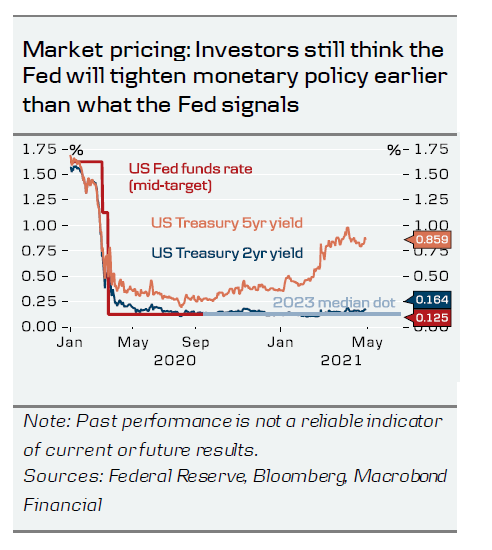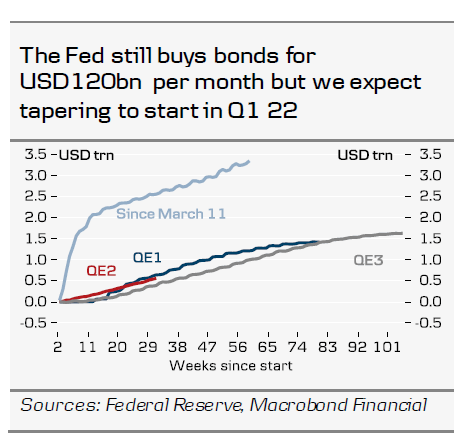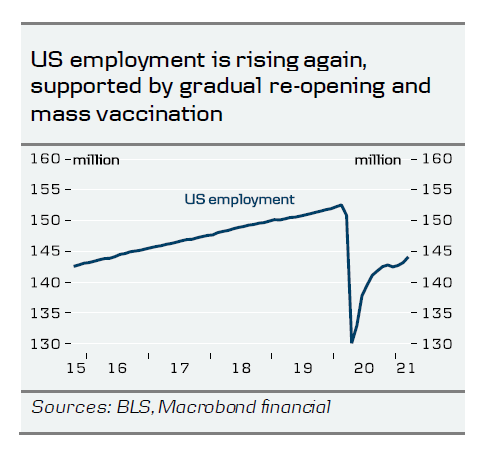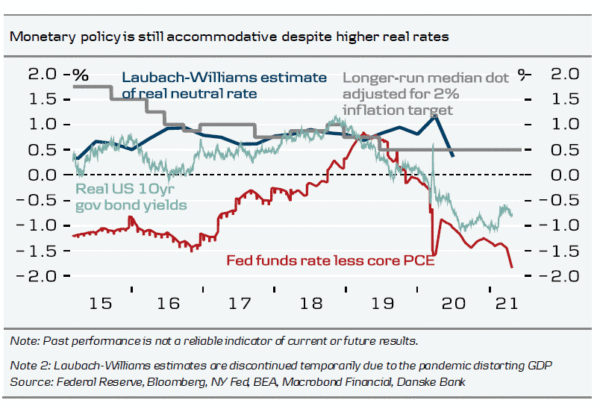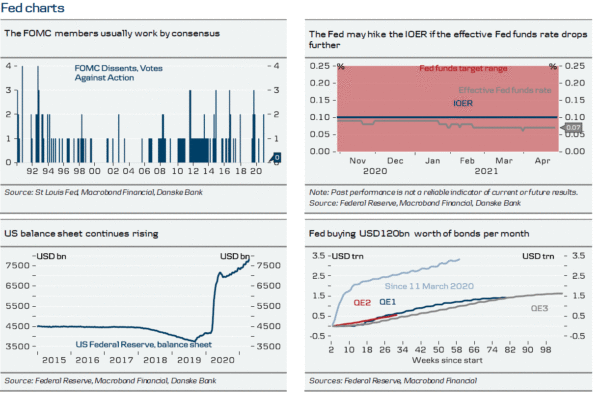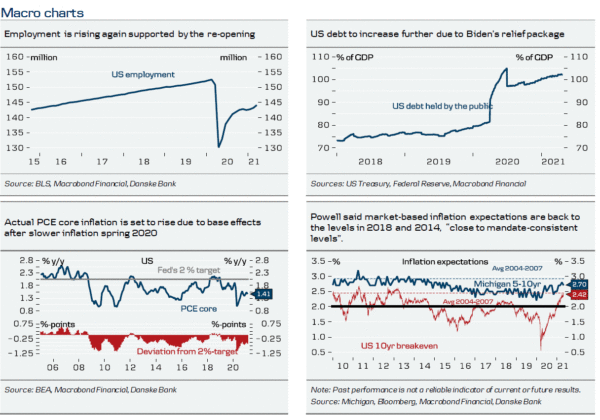Key takeaways
- As expected, the Fed kept monetary policy and policy signals unchanged. Interim meeting so there were no new forecasts or ‘dots’.
- Most importantly, Fed chair Powell said that ‘It is not the time to start talking about tapering’, highlighting what we wrote in our preview: The Fed is outcome-based, not forecast-based.
- The Fed is more up beat on the economy , downgraded the risk outlook to ‘risks remain’ (from ‘considerable risks’) and say s higher inflation is mostly due to ‘transitory effects’.
- Based on our very positive US macro outlook, we continue to see the Fed moving in a more hawkish direction later this year when more positive US macro data start to arrive. Our base case is September. We still think actual tapering will start in January 2022.
- We still see US rates to move higher later in the year. Dovish fed fuels further reflation trading and the dollar will remain on weak footing near-term
Fed: Outcome-based, not forecast-based
In line with our expectations, the Fed kept monetary policy and policy signals unchanged. The Fed still says ‘it will be appropriate to maintain this target range (0.00- 0.25%) until labor market conditions have reached levels consistent with the Committee’s assessments of maximum employment and inflation has risen to 2 percent and is on track to moderately exceed 2 percent for some time’ and that the bond buying pace is unchanged ‘until substantial further progress has been made’.
Very interestingly, Fed chair Powell said that ‘It is not the time to start talking about tapering’. This comment sent US yields lower (US 5yr Treasury yields dropped by 5bp) and EUR/USD above 1.21. Powell’s comments sup p ort our view that the Fed will prefer to err on the cautious side and that the Fed is outcome-based, not forecast-based. We still believe the Fed will become more hawkish later in the year (probably in September) due to strong US macro data. Given Powell’s dovish comment, we think it is unlikely that the Fed will change rhetoric already in June.
The Fed was more upbeat on growth than what we expected. The Fed recognises that economic activity has increased due to a combination of mass vaccination and policy support. The Fed repeated that ‘The sectors most adversely affected by the pandemic remain weak’ but added that they ‘have shown improvement’. Also noteworthy, the Fed downgraded the risks to the economy now saying that ‘risks to the economic outlook remain’, where the Fed previously talked about ‘considerable risks’.
As expected, the Fed says inflation has risen but that it is ‘largely reflecting transitory factors’. Fed Vice Chair Clarida as previously said they are not going to look at inflation right now, which is distorted by the price changes spring last year, but will wait and see how high inflation is in Q4. That said, Fed Chair Powell hinted they are looking at evidence of growing price pressure and whether it is just temporary in nature or not. Fed Chair Powell also said market-based inflation expectations are close to ‘mandate – consistent’ levels.
We continue to expect the Fed will start tapering at the January 2022 meeting (pace: USD20bn per meeting). We expect the first Fed rate hike to arrive in H1 2023. Looking at the balance of risk, we think risk is tilted towards a more hawkish Fed tapering at a faster pace and hiking rates already in 2022.
Fixed income: US rates to move higher later in the year
The rep eat of the ‘soft’ stance from M arch pushed US yields slightly lower, as we argued in the preview.
However, the April FOMC was a ‘small’ meeting and all market attention will soon turn to the June and September meetings and the probability of a change of rhetoric and possible tapering news. We hold the view that the market will over the coming two quarters price in both an earlier and faster normalisation of US Fed funds and higher inflation and real rate expectations. We have a 2.0% six months target for 10Y UST yields. We assume that the market will start price in a rate hike in Q4 2022. For more see Yield Outlook that we published 21 April.
Note that front-end Fed Funds futures rose on the statement; i.e., the market priced out some probability of an IOER and/or RRR tweak over the coming meetings. Powell repeated it is still something Fed would consider. We think a 3-5bp tweak of one or both rates would come if Effective Fed Funds drops to 0.05-0.06% over the coming weeks or months.
USD: Dovish Fed fuels further reflation, dollar to stay on weak footing near-term.
During Q1, the main theme for the dollar has been adapting to tightening Chinese liquidity conditions, parring dollar shorts and working through muddled communication from the Fed. These factors helped strengthen the dollar, in line with our expectation. As of yesterday, the reflation theme seems to be back.
Powell explicitly said higher inflation expectations would be welcome and that the employment gap (versus pre-covid employment levels) is still large. In practice, this means there is 3 to 6 months before Fed starts to talk about tapering. For now, this probably also means we are unlikely to see the dollar rise materially. Thus, while we have been seeing ‘p eak reflation’ as a theme to p rogress further in to Q2, it seems we probably need to go with the post-Easter market momentum (weaker dollar) and delay our expectation and trading ideas which benefit from such peak in the reflation theme. This most notably goes for NOK which has enjoyed strong support in recent weeks. For those with either dollar income, and/or assets we continue to recommend using participating forwards on a 6-12M horizon.




